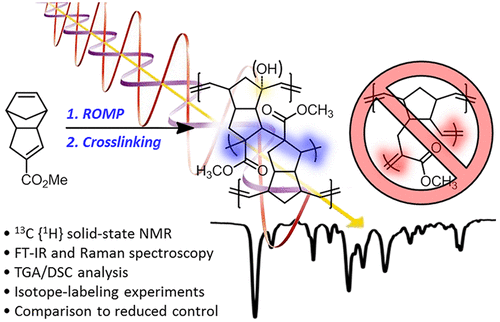当前位置:
X-MOL 学术
›
Macromolecules
›
论文详情
Our official English website, www.x-mol.net, welcomes your feedback! (Note: you will need to create a separate account there.)
Structure of the Thermally Induced Cross-Link in C-Linked Methyl Ester-Functionalized Polydicyclopentadiene (fPDCPD)
Macromolecules ( IF 5.5 ) Pub Date : 2018-02-28 00:00:00 , DOI: 10.1021/acs.macromol.7b02750 Tyler J. Cuthbert 1 , Tong Li 1 , Alexander W. H. Speed 2 , Jeremy E. Wulff 1
Macromolecules ( IF 5.5 ) Pub Date : 2018-02-28 00:00:00 , DOI: 10.1021/acs.macromol.7b02750 Tyler J. Cuthbert 1 , Tong Li 1 , Alexander W. H. Speed 2 , Jeremy E. Wulff 1
Affiliation

|
Polydicyclopentadiene (PDCPD) is a durable, highly cross-linked material that is used industrially for the production of automotive body panels among other applications. We recently described a novel C-linked, ester-functionalized polydicyclopentadiene (fPDCPD) that introduces a tunable surface energy and increased Tg, without sacrificing the desirable thermal stability of the parent polymer. In this report, we describe an extensive spectroscopic study aimed at the rigorous characterization of the structure of the cross-link in our thermally cured material. The results from this study rule out the involvement of metathesis-derived interchain couplings and show that the majority of cross-links derive from thermally initiated radical polymerization of the embedded methyl methacrylate motif. We also show that the degree of cross-linking can be tuned by the applied thermal conditions; rapid high-temperature heating freezes the system at a relatively low cross-link density, while longer heating at a lower temperature allows cross-linking to proceed nearly to completion.
中文翻译:

C链甲基酯官能化的聚二环戊二烯(f PDCPD)中热诱导交联的结构
聚二环戊二烯(PDCPD)是一种耐用的,高度交联的材料,除其他应用外,还用于工业生产汽车车身板。我们最近描述了一种新型的C键联,酯官能化的聚二环戊二烯(f PDCPD),它引入了可调的表面能并提高了T g,而不会牺牲母体聚合物的所需热稳定性。在这份报告中,我们描述了一项广泛的光谱研究,旨在对我们的热固化材料中的交联结构进行严格的表征。这项研究的结果排除了易位衍生的链间偶联的参与,并表明大多数交联源自嵌入的甲基丙烯酸甲酯基序的热引发自由基聚合。我们还表明,可以通过应用的热条件来调节交联度。快速的高温加热将系统冻结在较低的交联密度下,而在较低的温度下进行较长时间的加热可使交联几乎完成。
更新日期:2018-02-28
中文翻译:

C链甲基酯官能化的聚二环戊二烯(f PDCPD)中热诱导交联的结构
聚二环戊二烯(PDCPD)是一种耐用的,高度交联的材料,除其他应用外,还用于工业生产汽车车身板。我们最近描述了一种新型的C键联,酯官能化的聚二环戊二烯(f PDCPD),它引入了可调的表面能并提高了T g,而不会牺牲母体聚合物的所需热稳定性。在这份报告中,我们描述了一项广泛的光谱研究,旨在对我们的热固化材料中的交联结构进行严格的表征。这项研究的结果排除了易位衍生的链间偶联的参与,并表明大多数交联源自嵌入的甲基丙烯酸甲酯基序的热引发自由基聚合。我们还表明,可以通过应用的热条件来调节交联度。快速的高温加热将系统冻结在较低的交联密度下,而在较低的温度下进行较长时间的加热可使交联几乎完成。



























 京公网安备 11010802027423号
京公网安备 11010802027423号